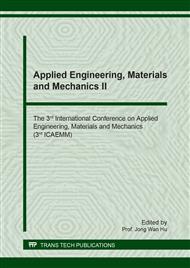[1]
A. Tewarson, J. Quintiere, D. Purser, Comprehensive Analyses of Post Collision Motor Vehicle Fires, Norwood, MA, Charlottesville, VA, FM Global (2005) 3018009.
Google Scholar
[2]
J. Santrock, D. W. Kononen, Flammability Properties of Engine Compartment Fluids Other than Gasoline: Auto-Ignition Characteristics of Non-Gasoline Motor Vehicle Fluids on Heated Surfaces. GM Report (2002).
Google Scholar
[3]
A. Tewarson, Thermophysical and fire properties of engine compartment fluids, SAE Technical Paper (2005).
DOI: 10.4271/2005-01-1560
Google Scholar
[4]
J. Quintiere, A theoretical basis for flammability properties, Fire Mater. 30 (2006) 175-214.
DOI: 10.1002/fam.905
Google Scholar
[5]
A. F. Grand, J. O. Trevino, Flammability screening and fire hazard of industrial fluids using the cone calorimeter, Fire Resistance of Industrial Fluids: ASTM International (1996).
DOI: 10.1520/stp16288s
Google Scholar
[6]
X. Chen, S. X. Lu, C. H. Li, J. Zhang, K. M. Liew, Experimental study on ignition and combustion characteristics of typical oils, Fire Mater. 38 (2014) 409-417.
DOI: 10.1002/fam.2191
Google Scholar
[7]
K. Suzuki, O. Sugawa, A. Yamagishi, K. Miyagi, K. Kamiya, Experimental study on ignition and combustion behaviors of insulation fluids for transformer using cone calorimeter, IEEJ. B. 127 (2007) 797-802.
DOI: 10.1541/ieejpes.127.797
Google Scholar
[8]
D. H. Hellebuyck, H. P. Van, T. Magnusson, et al, Fire behaviour of less-combustible dielectric liquids in a nuclear facility. Fire Technol. 52 (2016) 289-308.
DOI: 10.1007/s10694-015-0480-3
Google Scholar
[9]
ISO 5660-1, Fire Tests-Reaction to Fire – Heat Release, Smoke Production and Mass Loss Rate, in: Part1:Heat Release Rate (Cone Calorimeter Method) (2015).
DOI: 10.3403/30255889u
Google Scholar
[10]
Babrauskas V, Ignition handbook: principles and applications to fire safety engineering, fire investigation, risk management and forensic science, Issaguah, WA, (2003).
DOI: 10.1177/1042391504042549
Google Scholar
[11]
M. Janssens, Piloted ignition of wood: a review. Fire Mater. 15 (1991) 151-167.
DOI: 10.1002/fam.810150402
Google Scholar
[12]
X. Almeras, B. M. Le, P. Hornsby, et al, Effect of fillers on the fire retardancy of intumescent polypropylene compounds. Polym Degrad Stab. 82 (2003) 325-331.
DOI: 10.1016/s0141-3910(03)00187-3
Google Scholar
[13]
B. Chen, S. X. Lu, C. H. Li, Q. S. Kang, V. Lecoustre, Initial fuel temperature effects on burning rate of pool fire. J Hazard Mater. 188 (2011) 369-374.
DOI: 10.1016/j.jhazmat.2011.01.122
Google Scholar
[14]
A. Tewarson, Generation of heat and chemical compounds in fires, in: P. J. DiNenno (Eds), SFPE Handbook of Fire Protection Engineering, (3rd edn), National Fire Protection Association, Quincy, Massachusetts, (2002).
Google Scholar
[15]
B. Schartel, T. R. Hull, Development of fire‐retarded materials—Interpretation of cone calorimeter data. Fire Mater. 31 (2007) 327-354.
DOI: 10.1002/fam.949
Google Scholar
[16]
C. Jiao, X. Chen, Flammability and thermal degradation of intumescent flame‐retardant polypropylene composites. Polym. Eng. Sci. 50 (2010) 767-772.
DOI: 10.1002/pen.21583
Google Scholar
[17]
B. Schartel, U. Braun, U. Schwarz, S. Reinemann, Fire retardancy of polypropylene/flax blends. Polymer. 44 (2003) 6241-6250.
DOI: 10.1016/s0032-3861(03)00692-x
Google Scholar
[18]
S. S. Han, W. K. Chow, Calculating FED and LC50 for testing toxicity of materials in bench-scale tests with a cone calorimeter. Polym. Test. 24 (2005) 920-924.
DOI: 10.1016/j.polymertesting.2005.06.009
Google Scholar


